Ryan Hall's Blog, page 221
September 7, 2016
Runner Finds Art Inspiration on the Trails
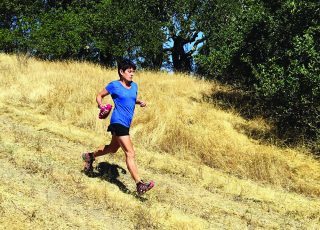
Photo: Wally Wallace
For 54-year-old ultrarunner Karen Hanke, the trails and the office each demand a lot of her time. Luckily for this award-winning children’s book illustrator, the trails double as her workplace.
As Hanke works through her freelance life, she often looks to the trails of Sugarloaf Ridge State Park just east of her home in Santa Rosa, Calif., for creative freedom and inspiration. As her body moves through the terrain, her mind wanders in a way that keeps creativity and inspiration fresh.
“Ideas come to you at different times,” Hanke says. “I’ll be going along and it comes … and all of a sudden everything is better.”
Hanke got into running while in college when she entered a 10K with her sister—and finished dead last together. After that, she decided to tackle the marathon. She followed the written plan in a beginner’s book and ran the Napa Valley Marathon.
Her Santa Rosa neighbor Rod Dickenson noted her athletic build and suggested she sign up for the Quad Dipsea, a hilly 28.4-mile trail race starting and finishing in Mill Valley, Calif. She had never explored the ultra world before, but in 1998 decided to give it a try.
She hasn’t missed the Quad Dipsea race since then (despite one unfinished year due to illness), giving her some distinction in the race’s history. She’s completed four 100-mile races: two Western States finishes in 2003-2004 and one apiece at the The Bear 100 Mile Endurance Run in 2013 and the Santa Barbara 100 in early July, not to mention dozens of sub-ultra trail races.
One children’s book that Hanke has illustrated, The Jazz Fly, garnered distinctions like “America’s #1 Recommended Children’s Book” from Children’s Book Sense, Smithsonian’s Notable Books for Children, the Writer’s Digest National Self-Published Book Award, and a host of others.
And when inspiration strikes, she captures it anywhere she can, often on the back of a receipt or a discarded envelope in her car at a trailhead.
She recalls running in Sugarloaf with a friend when he urged her to stop. As they stood still on the trail, they watched a mountain lion emerge, majestically situating on a rock for a couple minutes and licking a paw before slowly retreating into the grass nearby. Hanke dashed back to her car.
“I was so excited that I ripped off this grocery list to draw on and scanned it for myself,” she says. “I framed it and wrote the date, time and trail on there.”
The post Runner Finds Art Inspiration on the Trails appeared first on Competitor.com.
What’s Old is Cool Again: Vintage Running Shoes
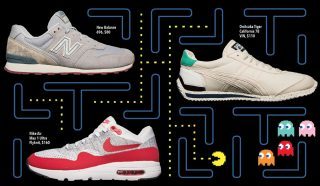
Photos: Oliver Baker; Illustration: Valerie Brugos
The concept of athletic footwear making the leap to lifestyle is nothing new. Long before Kanye West and Rihanna decided to collaborate with adidas and Puma, respectively, athletic shoe brands often aimed for “looks good with jeans” appeal.
But although we’ve long referred to casual footwear as “tennis shoes,” nowadays that actually means retro running shoes. And running brands are mining their back catalogs like never before, rereleasing classic models rebuilt with contemporary materials (like a Flyknit upper into the Air Max 1) and creative colorways (like Onitsuka Tiger’s Brazil-Japan artist collaboration on the California 78), and are meant to be worn dressed up or dressed down (like New Balance’s classic 696).
“Part of it is a cultural shift where nostalgia and authenticity have become valuable to the Millennial customer—and it also allows footwear brands to have an extension of their storytelling,” says Shane Downey, Brooks Running’s global director of Heritage.
Downey adds that the look and form of classic running shoes conveniently dovetails with current trends in fashion.
“When you think about a ’70s or ’80s running shoe, really streamlined and clean, it looks great with joggers or track pants or a really tailored pair of jeans,” Downey says. “Ten years ago, jeans were much wider, so the running shoe was overpowered by the jeans. It’s the flip side now. Pants are skinny, and the prominence of athleisure wear and sweatpants has definitely lent itself to this style of footwear.”
Claire Wood, senior product manager for performance running at New Balance, says mixing casual aesthetics and performance features takes cues from both sides. Last year, New Balance released a lifestyle version of its Fresh Foam Zante performance running shoe with an upper that looked and felt like an old-school sweatshirt. It sold out within a few weeks with very little marketing hype behind it.
And the trend should only get bigger and more ubiquitous. Fashion designers are increasingly featuring their own high-priced sneakers with retro running-shoe silhouettes on runways.
But even when fashion trends inevitably move on, don’t expect classic running shoes to go away. Brooks and other brands are increasingly rereleasing shoes from the ’90s, and, as apparel style changes, other decades of shoe design will surely be a hit with consumers.
As is often said, vintage never gets old.
The post What’s Old is Cool Again: Vintage Running Shoes appeared first on Competitor.com.
5 Innovative Music Items for Running to the Beat
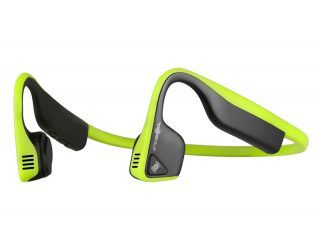
Anyone with a smartphone knows you can listen to music as you run. But look beyond your phone’s own music jukebox. We did—GPS watches that store and can play hundreds of songs, and headphones that keep you aware of your surroundings, can measure heart rate via your ear and even provide watch- and phone-free music and GPS workout tracks.
While running with music isn’t for everyone, some studies have shown that music at a beat near cadence or heart rate can improve performance and endurance by reducing perceived effort, boosting spirits when tired and by syncing the body’s rhythms to the music.
Photo Gallery
1 of {count}
Back to Start
View Larger Image
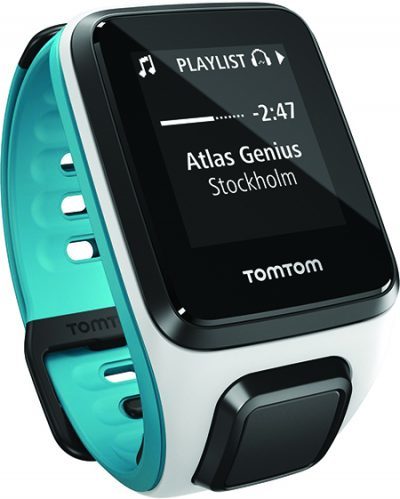
Music on the watch, not the phone
The admirably slim TomTom Spark Music ($200) GPS watch has a 3GB 500-song capacity Bluetooth-enabled music player on board. Many options to replace straps in fun colors are also available.
View Larger Image
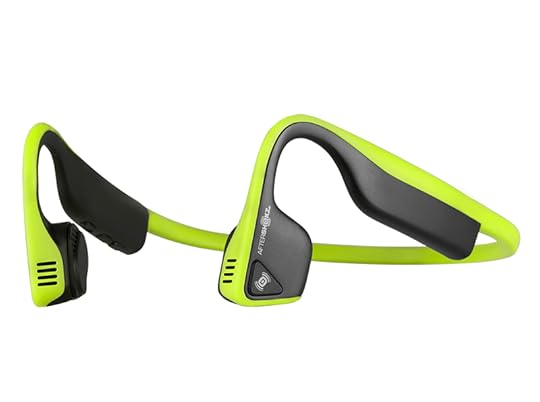
Hear what's around you
Headphones such as the Aftershokz Trexz Titanium ($130) conduct sound through the cheekbones, leaving your ears open to the outside world. So although the sound quality may not be as good, your situational awareness is.
View Larger Image
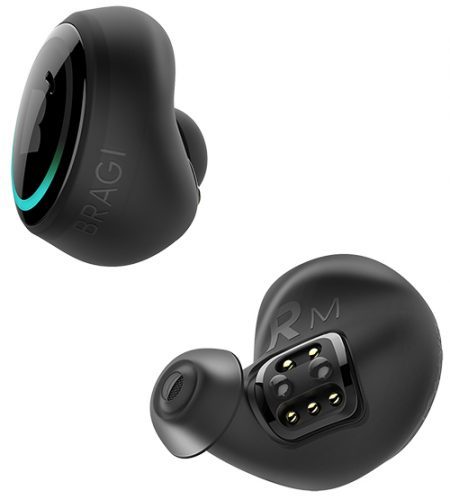
Tiny and loaded
The Bragi Dash ($299) Bluetooth earbuds aren’t much bigger than hearing aids—with no wires of any kind. They have a built-in 4GB music player and include ear heart rate, step and distance monitoring with audio feedback. Hear what’s happening around you through Audio-Transparency, or block ambient sound at the gym through Passive Sound Isolation. You can even listen to music as you swim—and yes, there is an optional leash.
View Larger Image
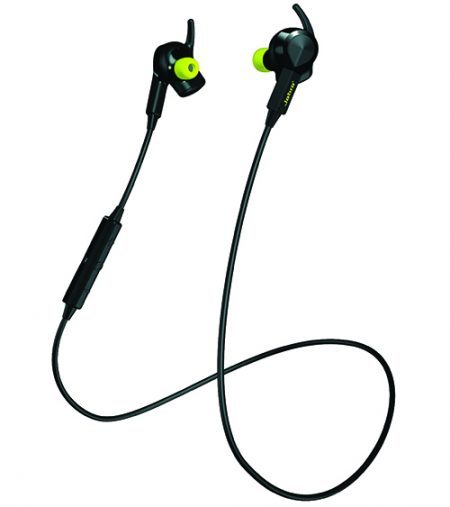
Music plus HR
Jabra’s Sport Pulse Earbuds ($200) are Bluetooth wireless to your phone with an optical heart rate monitor in the earbuds.
View Larger Image
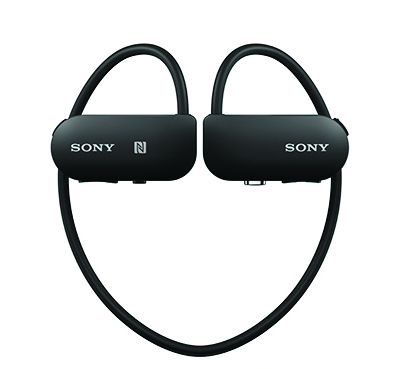
The do-it-all headphones
The somewhat geeky looking Sony Smart B-Trainer ($250) includes GPS and HR sensors plus storage for up to 3,900 songs. Music can be selected based on your target heart rate—and the B-Trainer will give you performance feedback along the way.
Related Galleries
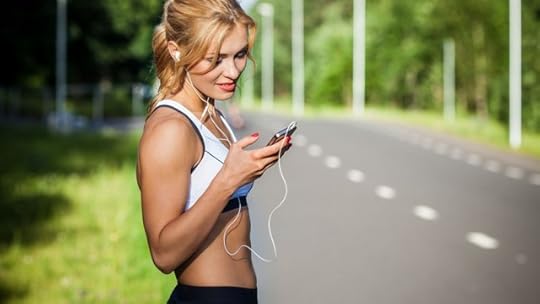
5 New Headphones Designed for Runners

More Galleries
The post 5 Innovative Music Items for Running to the Beat appeared first on Competitor.com.
Sneak Peek: Innovative New Music & Wearable Tech Gear for Running
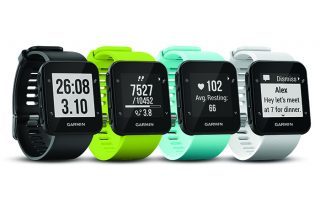
Game-improvement wearable tech gear—in other words, products aimed at helping you run better and more consistently—remains a white-hot category in running. The massive Aug. 3-6 Outdoor Retailer Summer Market trade show in Salt Lake City showed off a lot of new and improved trackers, watches, music accessories and tech apparel, but it also coincided with a big week of announcements and releases of wearable fitness tech for the upcoming holiday season. Click through the photos below for a look at some of the new wearable tech gear you’ll see in stores this fall and winter.
RELATED: Take a Sneak Peek at 2017 Running Shoes
Photo Gallery
1 of {count}
Back to Start
View Larger Image
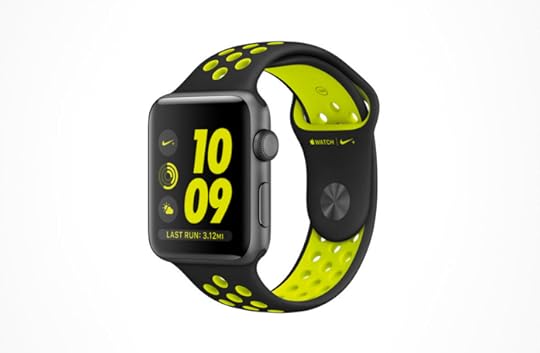
Apple Watch Series 2 & Apple Watch Nike+
On Sept. 7, Apple announced the Apple Watch Series 2. Of most significance to runners is that the watch now includes a rapid acquisition GPS chip so it can now be run without a phone. (It is swim rated to 50 meters with an innovative speaker which ejects water.) The screen is two times brighter than the original for hopefully improved readability on run. (The original Apple Watch was very difficult to see in bright light.) Battery life stats were not unveiled during the presentation, but they were a concern and a limitation of the original Apple Watch. It is available in many case and band styles, including a new super-hard white ceramic case.
Apple and Nike also introduced the Apple Watch Nike+ ($369), something that Nike is calling “the perfect running partner.” With a light aluminum case, the Nike watch features exclusive Nike Sports Bands and a watch version of Nike+Run Club app focused on simplicity, daily motivation, smart run reminders and a special emphasis on “Just Do It” Sunday runs. With basic run stats and an advanced mode for the runner focused on deeper data and metrics, we can’t wait to try the Nike+ watch. Other run apps are sure to follow with their own innovative Apple Watch apps now that the watch has GPS. (The Apple Watch Series 2 will be available for pre-order on Sept. 9, while the Nike+ model will be available in late October.)
Apple’s iPhone 7 will have many new features and upgrades. Of most interest to runners is the claimed longest battery life of any iPhone to date, an optically stabilized improved camera for on the run pictures, and very importantly for runners improved dust and water resistance to the IP67 standard which means it is totally protected from dust and protected from immersion between 1cm and 1meter. You can fall into a pool—as Apple showed in its presentation—and you will be OK in the rain, but our advice is not to try swimming with the phone. (The iPhone 7 will be available for pre-order on Sept. 9; shipping begins on Sept. 16.)
Apple also announced a new, completely wireless ear buds, Apple Air Pods ($159) as they eliminated the standard headphone jack. The Lightning connector is now the single all-purpose jack for charging and audio. Air Pods have a 5-hour battery life while in-use and 24 hours of power available from a very clever charger case, which will do dual duty to help you keep from losing them. Each pod has dual microphones and they can used as a pair or solo. (Available late October.)
View Larger Image
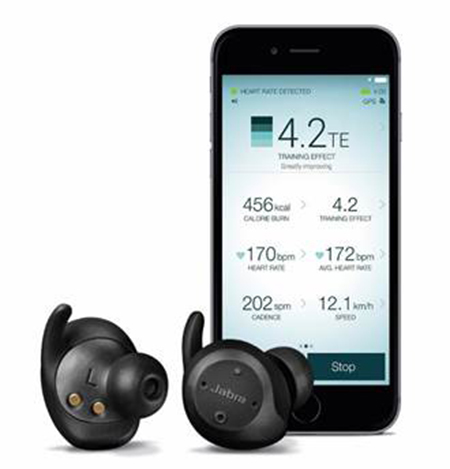
Jabra Elite Sport
Fresh on the heels of the new Sports Pulse Special Edition Headphones, Jabra has also unveiled its Elite Sport earbuds ($250). Truly wireless with the possibility to run with both buds or just one, think no music just app stats and better situational awareness, the Elite is water and sweat proof, has 3 hour music and call battery life, and auto switching dual microphones in each bud for better phone call sound quality. Run features include an in ear heart rate monitor with the Jabra app also calculating VO2 Max and providing real time coaching. (Available in November.)
View Larger Image
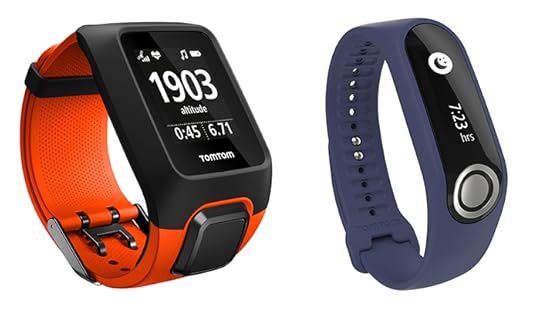
Tom Tom Adventurer + Touch
TomTom is debuting the Adventurer ($350), a new trail and mountain activities-oriented GPS watch with an integrated music player and wrist heart rate sensing capabilities. It includes a barometric altimeter for more accurate and responsive real-time vertical tracking, a compass and Route Exploration features—including the ability to upload a route to the watch and follow, as well as back-to-start navigation. (Available in September.) Meanwhile, the Touch ($130) is a heart rate and activity tracker band with an unusual touch, a finger press body composition sensor (percentage of body fat and muscle mass). Also of note, all four Spark 3 GPS watches from the $130 GPS to the 250 Cardio+Music+HP) now come with Route Exploration, an improved a free Bluetooth headset a sleeker slimmer design, and no increase in prices. (Available Sept. 8.)
View Larger Image
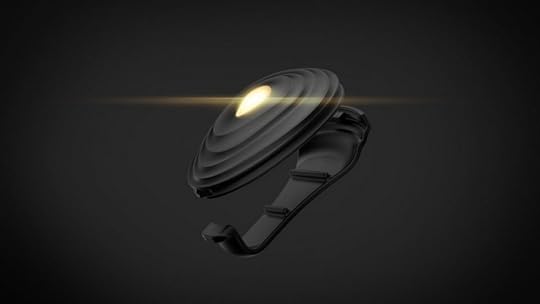
Stryd
Stryd, the first running-specific power meter, has smartly been switched from a chest heart rate strap device to a shoe-clip sensor. From its inception, Stryd ($199) has tracked a variety of data, delivering heart rate, cadence, impact, movement, form, altitude and power values to its smartphone app and several smartwatch brands. The Stryd system offers power value in real time, with no data lags like most heart-rate monitors. It serves up both audio feedback on the run and post-workout feedback for long-term improvement. Added to the 12 metrics that Stryd quantifies into run power is leg spring stiffness, which has been correlated to running efficiency by scientific studies, but never before available in a wearable. Leg spring stiffness can be increased by form changes and conditioning. (Available in September.)
View Larger Image
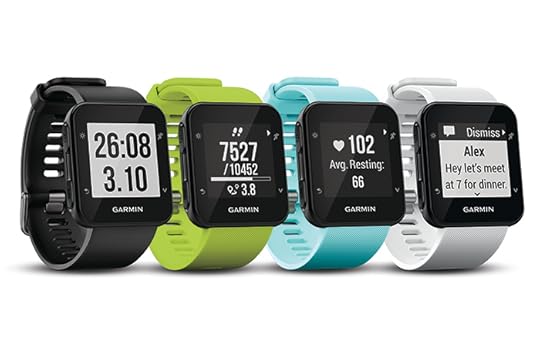
Garmin Forerunner 35
The just-announced Forerunner 35 ($200) has a stylish fresh design and comes in fun colors, including white, frost blue, limelight and black. It features Elevate 24/7 wrist heart rate monitoring, a new high-resolution and high-contrast monochrome display, 35 multi-sport profiles and a full suite of phone connectivity features with vibration alerts. A great value at $200, it slides into the Garmin lineup at $50 less than its color touch-screen cousin Vivoactive HR and $20 less than the tiny GPS run and activity band Vivosmart HR+. (Available this fall.)
View Larger Image
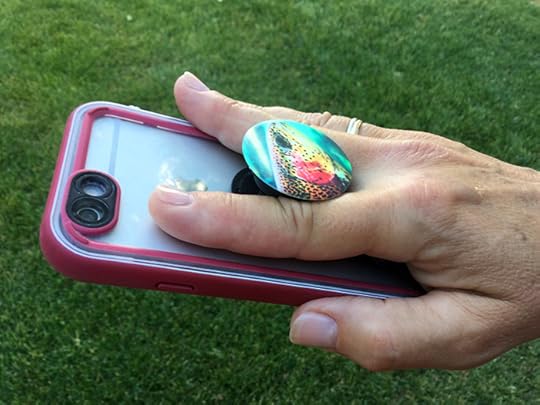
PopSockets
These colorful, ingenious, collapsible stick-on disks ($10-$15) immediately caught our eye at the trade show. Pop them out to one of two positions and slip your fingers against the soft ridged bellows below the disk to securely hand carry your phone. Run app stats are a turn of the wrist away and fast pictures or texts on the go are a breeze. Reusable for multiple times, they also become a video view stand and headphone cord wrap. (Available now.)
View Larger Image
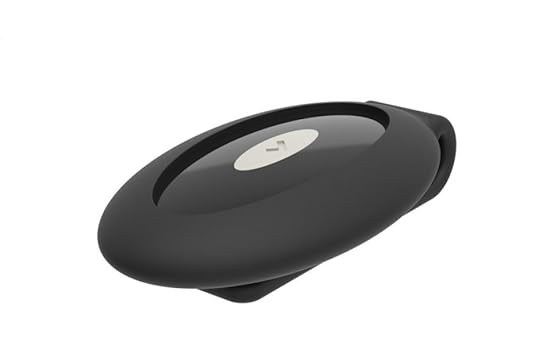
Lumo Run
Lumo Run offers two ways to track running data and improve running form and efficiency through a clip-on sensor pod ($100) or sensor-integrated apparel—running shorts for men ($199) and running capris for women ($199). Lumo’s
sensors capture accurate running biomechanics
through core body movements. The Lumo system tracks five key running metrics—cadence, bounce, braking, rotation and drop—and offers audible real-time performance feedback for each one, as well as post-run summaries and coaching tips. The in-run tips and audio coaching are easy to do and effective, with post-run exercises addressing the areas that need improvement spot on.
View Larger Image
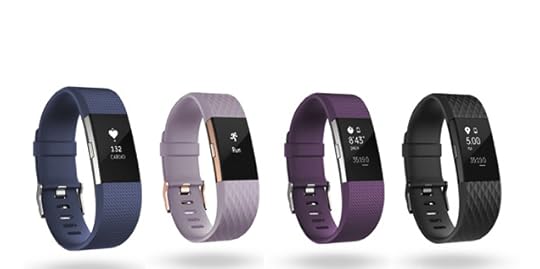
FitBit Charge 2
The top-selling fitness tracker and wearable device has been updated with stylish interchangeable bands—including luxe leather options—a much larger screen, multiple watch faces, and new fitness and connection features, all at the same size and base price ($149.95). New running and fitness features include multi sport—select your activity and see appropriate metrics including when phone connected GPS run stats., an estimate of VO2 Max, a simple fast/slow time-based interval mode, and on demand guided breathing pauses informed by heart rate variability. Phone connectivity adds calendar and text notifications to the original Charge HR’s call notifications. (Available now.)
View Larger Image
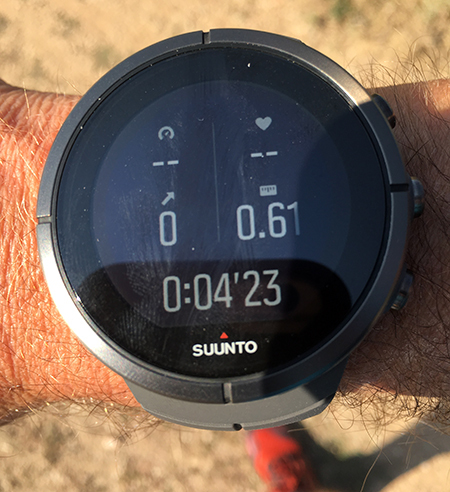
Suunto Spartan Ultra
We have been trail and road running with Sunnto’s new top of the line, multisport, mountain-focused GPS watch, and we liked it for a lot of reasons. A beautiful, light and easy on the wrist “big” watch, the Spartan Ultra ($699 to $799) has a sapphire touch screen. The wide viewing angle, high-resolution, color screen with classy modern analog and digital watch faces sets a new standard for on-the-run bright light multi-data field legibility and even navigation. It's much more user friendly than most high-end smartwatches we've tested, thanks to a much more intuitive functionality. (Available now; a slightly thinner triathlon-focused Spartan Sport will arrive later this year.)
View Larger Image

Strava Beacon
Strava Premium users were upgraded in mid-August with Beacon, a safety and race tracking feature which allows up to three contacts to get a text when you start a run, follows you on a map, and finally receives a text when you stop recording or have a low battery. The free version recently received an upgrade to the large, super clear display format formerly reserved for Premium.
View Larger Image
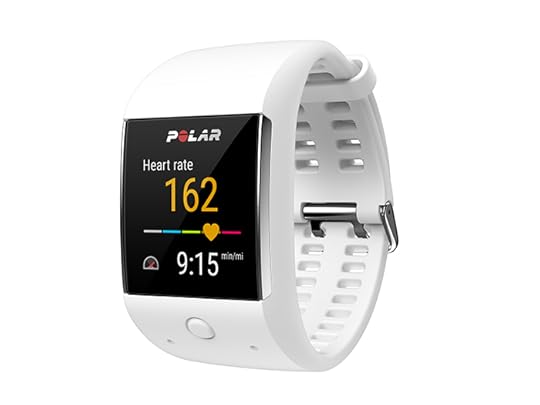
Polar M600 Smart Watch
Heart rate monitoring pioneer Polar’s first wrist-based heart rate GPS watch, the sleek, color screen M600 ($330) is based on Google Android Wear. You get Polar’s excellent training watch features and platform along with the open Android Wear operating system, dramatically extending the 24/7 utility and customizability of the watch, particularly for Android phone users. They can access the 4000 Android Wear apps and even turn the watch into a standalone music player. In our initial testing we loved the small size, very high-resolution screen and phone connectivity. We noticed all-day battery life is shorter than conventional GPS “smartwatches” when phone connected, about two days Android, one day iPhone or from a full charge up to eight hours in training mode. (Available now.)
View Larger Image
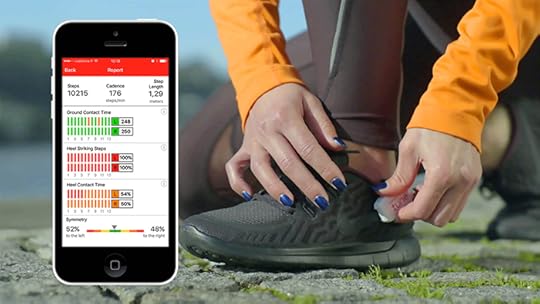
Tune Sensor Insoles and App
New from Portugal-based Kinematix, Tune ($200) is a sensor and app package that seeks to reduce your overall ground contact time and how much of your contact is at the heels, both seen as keys to running efficiency by some studies. Data comes from a pair of very thin (2mm) insoles embedded with force sensors and accelerometers that slip under your usual shoe sock liner. The GPS app provides in-run audio cues. The insoles can also be paired to Android smartwatches with GPS to go phone free. After the run, performance can be reviewed in detail augmented by the incorporated GPS tracking. Exercises based on crunching the data, complete with video demos, are provided, and then personalized after a period of data capture. (Available in late September.)
View Larger Image
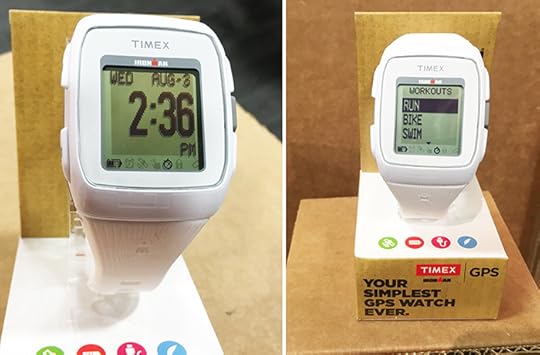
Timex Ironman GPS Watch
Billed as “the Simplest GPS Watch, Ever,” the latest sport watch from Timex ($99) has intuitive, one-button functionality, a 12-hour battery life (even in full GPS mode) and charges with a micro USB port—meaning no proprietary connection cords—to download workouts (no app) and there is an optional color strap ($14.99). Powered by the latest fast acquisition GPS chip, this watch does all the basics of distance, average pace and time. It has a simple triathlon mode of run, swim, ride, but it will only capture time in the water. (Available now.)
View Larger Image

Whoop
The Whoop system ($500) seeks to help athletes understand how well they are sleeping and responding to stressors of workouts, and life, so as to better inform what level of effort (or any stress) may be advisable for the day. It samples heart rate 24/7 and more frequently than other bands at up to 100 times per second. Whoop captures and interprets the difficulty in capturing key metric of Heart Rate Variability (HRV). Studies have shown HRV occurs in the last 5 minutes of slow wave sleep and is key to understanding just how ready you are for a planned workout or any stressors that day. Originally developed for and only offered to pro and elite athletes, Whoop band and system are available to the public on a pre-order basis. (Available in December.)
View Larger Image
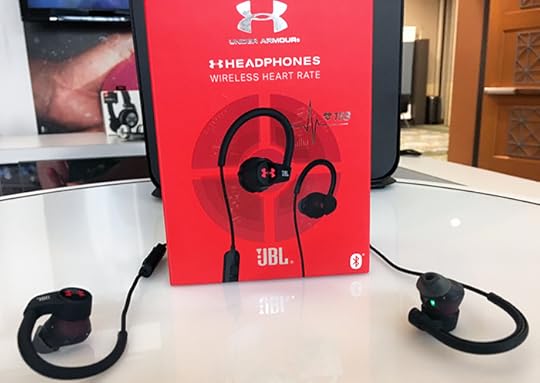
Under Armour JBL Wireless Heart Rate Monitoring Headphones
These tiny, comfortable Bluetooth earphones ($200) incorporate a military-grade heart rate optical sensor, used in fighter pilot helmets. Swipe on an ear bud and hear an audible read out of your heart rate. It pairs with most run apps, and we tried it with both Under Armour’s MapMy Run and Strava. (Available in October.)
View Larger Image
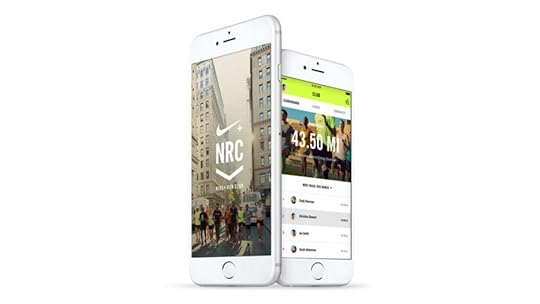
Nike+ Run Club App
Nike released a completely redesigned, updated version and renamed version of its popular Nike+Running app. Run Club, as the name implies, increases ways to sticker and share runs, be inspired and motivated through hashtag-based challenges, leaderboards and by following the run tips, Nike+ music mixes, and community elements in a colorful feed. Run with a Garmin, Wahoo, or Tom Tom device? You can now bring that data into Nike+Run Club. The app now incorporates an adaptive coaching system that starts with your goals and run volume, builds a plan, and then is supposed to respond to your performance and needs as you use it. Tested with Nike’s global coaches and elites, the app will adapt your plan based on your actual run performances along with short, timed, audio coached benchmark runs. (Available now)

More Galleries
The post Sneak Peek: Innovative New Music & Wearable Tech Gear for Running appeared first on Competitor.com.
September 4, 2016
Photos: 2016 Rock ‘n’ Roll Virginia Beach
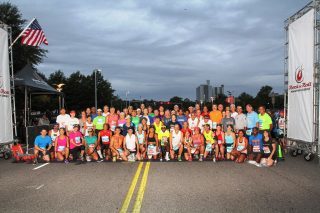
Legacy runners gather at the start line. More than 80 participants have run the Rock ‘n’ Roll Virginia Beach Half Marathon all 16 years. | Credit: Kevin Morris / PhotoRun.net
Photo Gallery
1 of {count}
Back to Start
View Larger Image
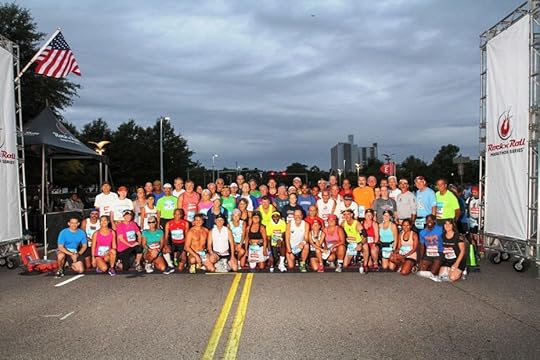
Legacy runners gather at the start line. More than 80 participants have run the Rock ‘n’ Roll Virginia Beach Half Marathon all 16 years. | Credit: Kevin Morris / PhotoRun.net
View Larger Image
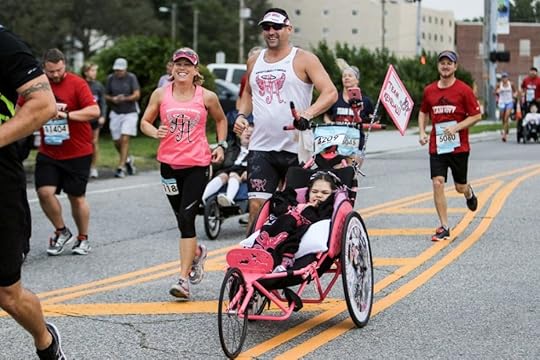
Ainsley’s Angels is an organization that aims to make endurance events accessible to everyone and build awareness about America’s special needs community. | Credit: Kevin Morris / PhotoRun.net
View Larger Image
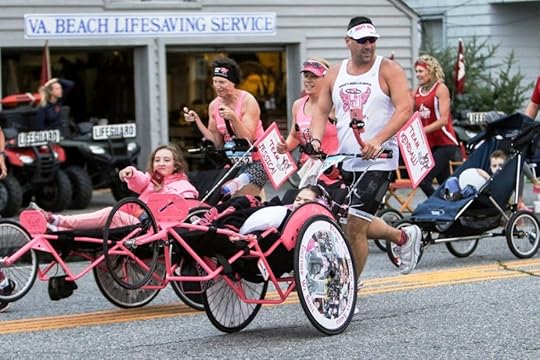
Ainsley’s Angels is an organization that aims to make endurance events accessible to everyone and build awareness about America’s special needs community. | Credit: Kevin Morris / PhotoRun.net
View Larger Image
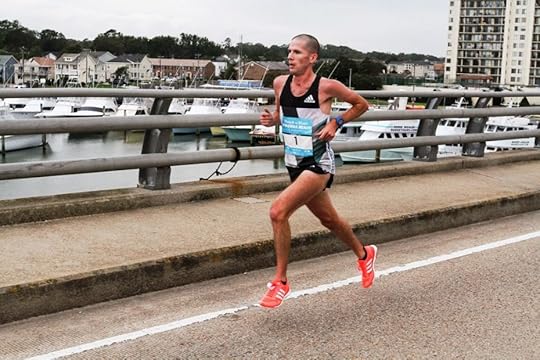
Jonathan Gray said afterwards came to Virginia Beach to prepare for racing the New York City Marathon in November. | Credit: Kevin Morris / PhotoRun.net
View Larger Image
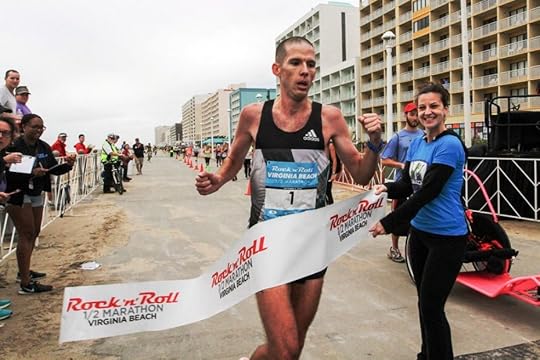
From Louisville, Colorado – Grey blazed the scenic beach-front course to win the half marathon by over 7 minutes in 1:04:26 seconds. | Credit: Kevin Morris / PhotoRun.net
View Larger Image
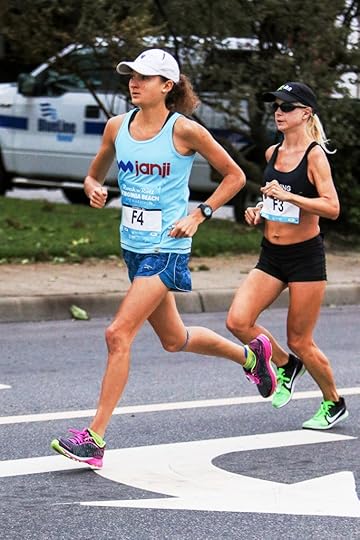
The women’s half marathon was much closer with Ildiko Gaal from Norfolk, Virgina, coming through the beachfront finish in 1:24:37. | Credit: Kevin Morris / PhotoRun.net
View Larger Image
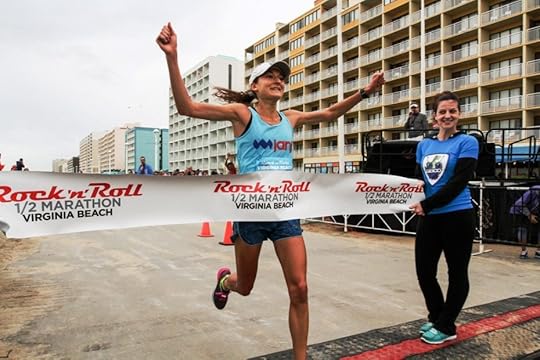
“It was a good race, but it was windy,” said the 25-year-old Gaal. “I didn’t even know if the race was going to happen (with the tropical storm), so I’m pleased.” | Credit: Kevin Morris / PhotoRun.net
View Larger Image
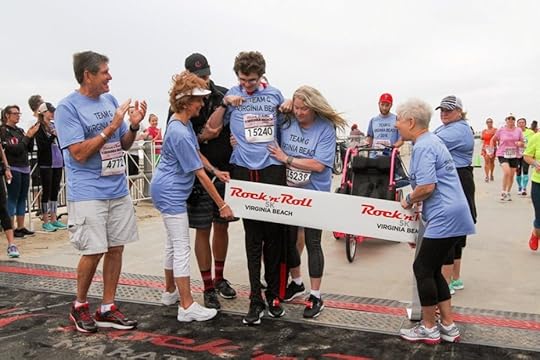
The most touching moment of the day, came when 18-year-old Greg Kenney crossed the finish line one year after collapsing on the course at mile 12.
View Larger Image
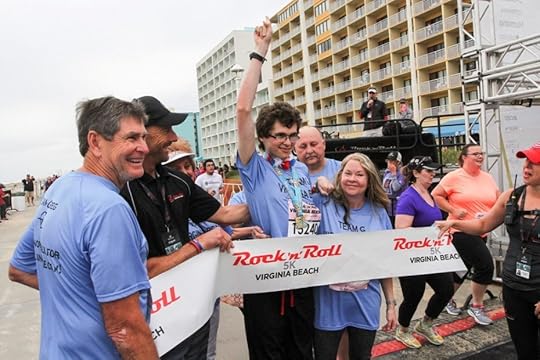
Greg was joined by Olympian Jim Ryun and family members to complete the 5k race. | Credit: Kevin Morris / PhotoRun.net
Related Galleries
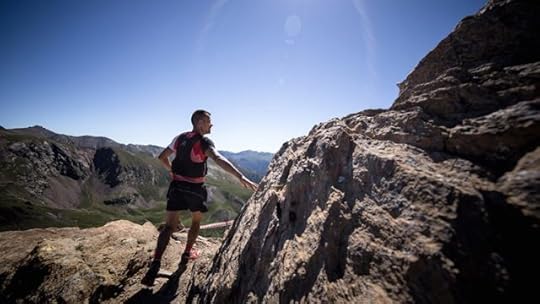
Photos: The 2016 Andorra Ultra Trail Vallnord
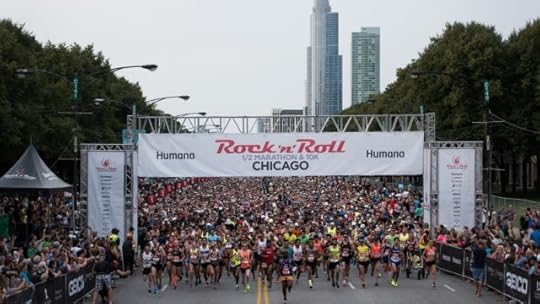
Photos: 2016 Humana Rock ‘n’ Roll Chicago Half Marathon
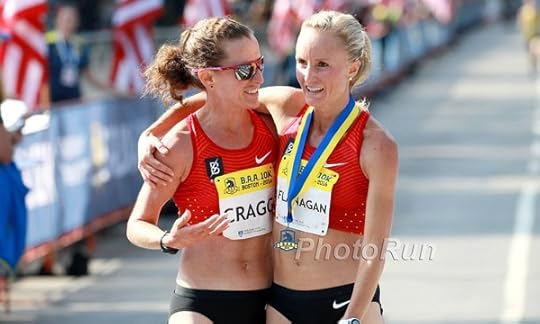
Photos: The Elites at the B.A.A. 10K

Photos: 2016 Bryce Canyon 100

More Galleries
The post Photos: 2016 Rock ‘n’ Roll Virginia Beach appeared first on Competitor.com.
Photos – 2016 Rock ‘n’ Roll Virginia Beach

Legacy runners gather at the start line. More than 80 participants have run the Rock ‘n’ Roll Virginia Beach Half Marathon all 16 years. | Credit: Kevin Morris / PhotoRun.net
Photo Gallery
1 of {count}
Back to Start
View Larger Image

Legacy runners gather at the start line. More than 80 participants have run the Rock ‘n’ Roll Virginia Beach Half Marathon all 16 years. | Credit: Kevin Morris / PhotoRun.net
View Larger Image

Ainsley’s Angels is an organization that aims to make endurance events accessible to everyone and build awareness about America’s special needs community. | Credit: Kevin Morris / PhotoRun.net
View Larger Image

Ainsley’s Angels is an organization that aims to make endurance events accessible to everyone and build awareness about America’s special needs community. | Credit: Kevin Morris / PhotoRun.net
View Larger Image

Jonathan Gray said afterwards came to Virginia Beach to prepare for racing the New York City Marathon in November. | Credit: Kevin Morris / PhotoRun.net
View Larger Image

From Louisville, Colorado – Grey blazed the scenic beach-front course to win the half marathon by over 7 minutes in 1:04:26 seconds. | Credit: Kevin Morris / PhotoRun.net
View Larger Image

The women’s half marathon was much closer with Ildiko Gaal from Norfolk, Virgina, coming through the beachfront finish in 1:24:37. | Credit: Kevin Morris / PhotoRun.net
View Larger Image

“It was a good race, but it was windy,” said the 25-year-old Gaal. “I didn’t even know if the race was going to happen (with the tropical storm), so I’m pleased.” | Credit: Kevin Morris / PhotoRun.net
View Larger Image

The most touching moment of the day, came when 18-year-old Greg Kenney crossed the finish line one year after collapsing on the course at mile 12.
View Larger Image

Greg was joined by Olympian Jim Ryun and family members to complete the 5k race. | Credit: Kevin Morris / PhotoRun.net
Related Galleries

Photos: The 2016 Andorra Ultra Trail Vallnord

Photos: 2016 Humana Rock ‘n’ Roll Chicago Half Marathon

Photos: The Elites at the B.A.A. 10K

Photos: 2016 Bryce Canyon 100

More Galleries
The post Photos – 2016 Rock ‘n’ Roll Virginia Beach appeared first on Competitor.com.
September 2, 2016
Nearly 90, Ellen Lem Rocks the Disneyland 5K

Anaheim runner Ellen Lem, who turns 90 in a few weeks; is one of the oldest runners ever to participate at a Disneyland Half Marathon Weekend presented by Cigna. Lem ran the 5K along with her two daughters in about 1:13.05.
Just weeks before her 90th birthday, Californian Ellen Lem completed the Disneyland 5K on Sept. 2, making her one of the oldest runners ever to participate in the Disneyland Half Marathon Weekend presented by Cigna.
Lem walks about 10 laps a day around Juarez Park, near her Anaheim home. She is often accompanied by her two adult daughters, who completed the 5K with her. When she began outpacing her daughters on their excursions the family decided to sign her up for the event, Lem’s first official race.
After the run, she told an interviewer that she looks forward to competing again next year—but at the 10K distance. “I loved it,” said Lem. “To see everyone walking and waving ‘Hi’ to me.”
Growing up in Asia during World War II, Lem and her family had to flee their native Burma and live as refugees in China where she nearly lost touch with her eventual husband. There she served as a volunteer translator for the American Red Cross and was eventually reunited with future husband, an American soldier who brought her to Anaheim where she has lived the past 40 years.
The post Nearly 90, Ellen Lem Rocks the Disneyland 5K appeared first on Competitor.com.
Medal Mania: Are We Going Overboard with the Awards?
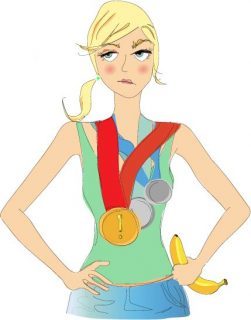
Illustration: Michelle Schrantz
Last weekend I did a 5K with my sister. It was nothing spectacular—3.1 miles in aesthetically pleasing scenery with about 800 new friends. No PRs were set. We gabbed most of the way (as sisters do), and I think we may have even stopped to take a selfie.
Yet at the finish line, one might think we had just won the whole darn thing.
“YOU DID IT!” A volunteer shouted as we crossed the timing mat. “I’M SO PROUD OF YOU!”
“WAY TO GO!” another woo-hooed as she handed us water bottles. A tunnel of high-
fiving children steered us toward a gaggle of local pageant winners, who were waiting to hand out medals.
“Good job!” Miss Dairy Days smiled as she lifted the hardware around my neck. And hardware it was: dangling from the end of a red ribbon was a bedazzled dinner plate. I have held babies that didn’t weigh as much as this behemoth of a finisher medal. A medal for the incredible act of finishing a 5K fun run.
Is it possible we’re going overboard with the awards these days? When I first started running, all I got at the finish line of a 5K was a banana. Now I get Hulk Hogan’s WWE belt.
Don’t get me wrong: I love finisher medals just as much as the next runner. There are a few hanging on the wall in my basement. I sometimes wear mine to post-race breakfasts as a shameless way to get a complimentary side of bacon. My nieces and nephews enjoy stealing mine for awards in their make-believe Olympic Games (which includes amazing feats of strength like “cat wrangling” and “poop jokes.”)
But I also have more medals than I know what to do with. They tumble out when I open my car’s trunk and rattle around in the silverware drawer. I once found a medal in the dishwasher, as if to say, “Kudos for using lavender-scented soap!”
RELATED: What Can You Do with Your Race Medals?
The fanfare surrounding finisher medals has inflated my expectations outside of running, too. After I get a medal for meandering my way through a fun run, I start to expect praise for everything I do. My boss wasn’t too pleased when I requested my pay be
written on massive checks and presented by Ed McMahon. (At the very least, couldn’t he get Miss Dairy Days to deliver it?)
Perhaps we should return to a simpler time, when races handed out high-fives and bananas. A finish line should not be an endpoint, but a springboard for the next challenge: to go farther, faster, harder. A medal implies finality, as if one has reached the pinnacle of success as a runner. Too many people collect their medal, get free bacon at breakfast and never run again. The bucket list item has been checked off.
But if we can keep those runners coming back, they might discover something kind of cool: The reward of running is running itself, not a sparkly piece of tin that sits in a drawer somewhere. It’s the feeling of satisfaction, sense of community, stories and bragging rights, not to mention positive, self-perpetuating steps toward a healthy life.
Free bananas are a pretty sweet prize, too.
The post Medal Mania: Are We Going Overboard with the Awards? appeared first on Competitor.com.
Shell Game: The Latest Weatherproof Running Jackets
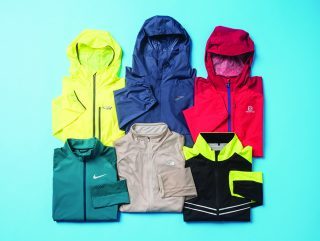
Photo: Oliver Baker
No excuses. The latest crop of lightweight running jackets are designed to keep you running comfortably even when fall weather turns cold, breezy and damp. Zip up and go!
Photos: Oliver Baker
Photo Gallery
1 of {count}
Back to Start
View Larger Image
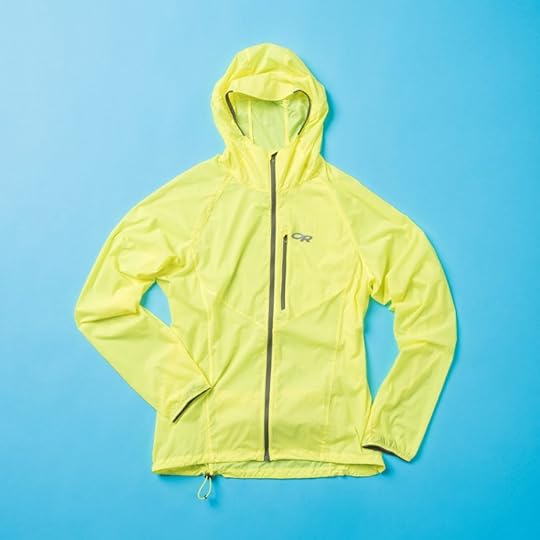
Outdoor Research Tantrum Hooded, $110
This shell stretches and breathes while resisting wind and water. Runner-
friendly details like a zip chest pocket, fitted hood and a zipper flap add functional comfort. Once skies clear, the jacket can be packed in the rear pocket
stuff sack and attached around your waist with the included elastic belt.
View Larger Image
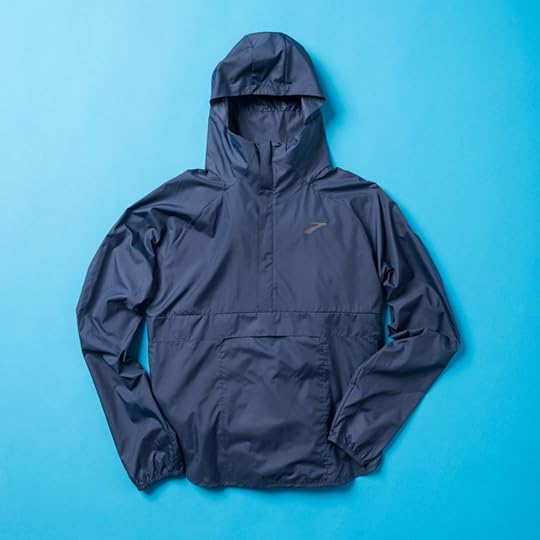
Brooks Cascadia Shell, $100
Part of Brooks’ first apparel collection specifically for the trails, this wind- and water-resistant half-zip closes with side tabs. The cut is sized to fit over a pack so you and your gear stay dry.
View Larger Image
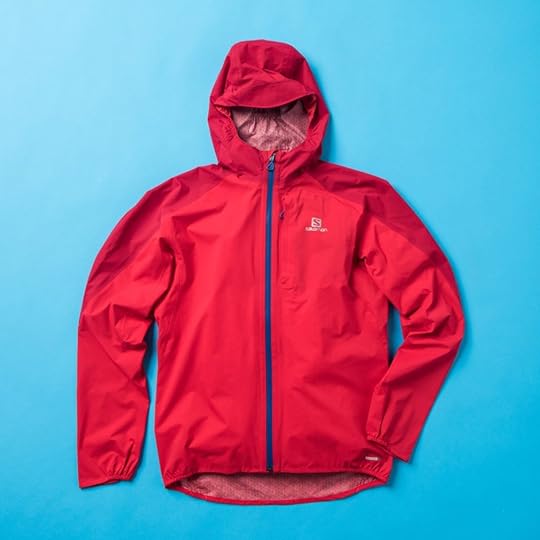
Salomon Bonatti Pro, $150
Streamlined looks bely the functionality of this feather-light, breathable, waterproof jacket. It even has a hood and weatherproof zipper, and packs into its own pocket, meaning there isn’t much more to ask for than a sunny day.
View Larger Image
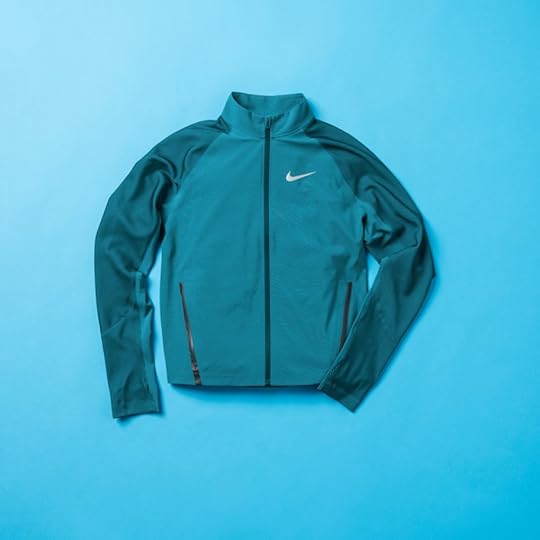
Nike Twill Running Jacket, $225
Look good and feel comfortable in damp conditions with water-repelling fabric and a sleek track-styled design. Stretchable fabric in the raglan sleeves adds mobility to the slim-fit style, and two handy zippered pockets stow your essentials.
View Larger Image
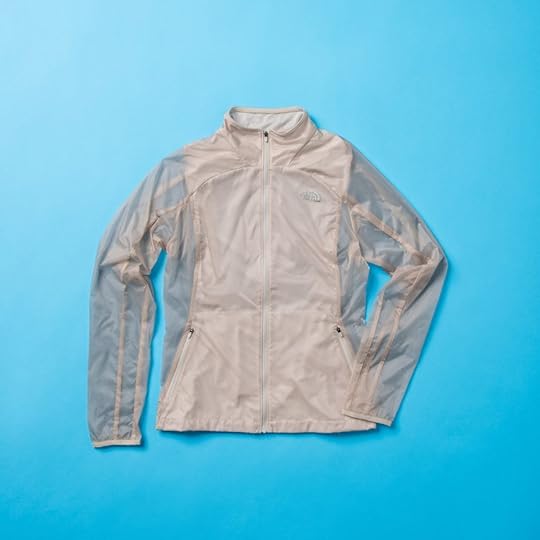
The North Face Winter Better Than Naked Jacket, $120
The Better Than Naked Jacket got a winter makeover with extra warmth and body-mapped venting to dissipate sweat. The wind-resistant jacket comes with zippered hand pockets for essentials and elastic-trimmed sleeves.
View Larger Image
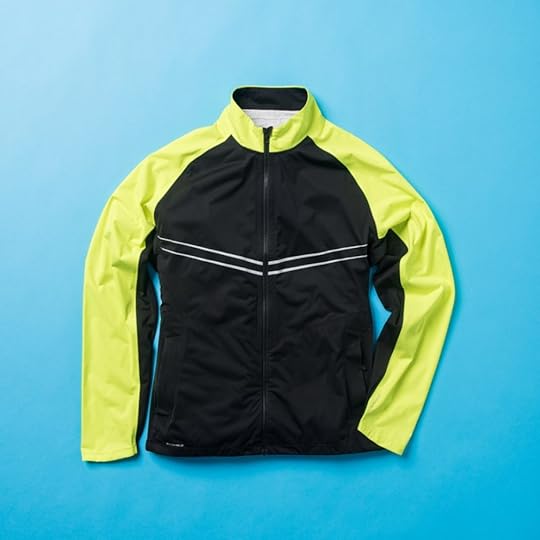
Saucony Razor, $175
Made with a sweat-
tested and breathable laminate material, the new windproof and waterproof Razor jacket is crafted with taped seams, a waterproof zipper and back vents for maximum comfort, even in miserable weather.
View Larger Image
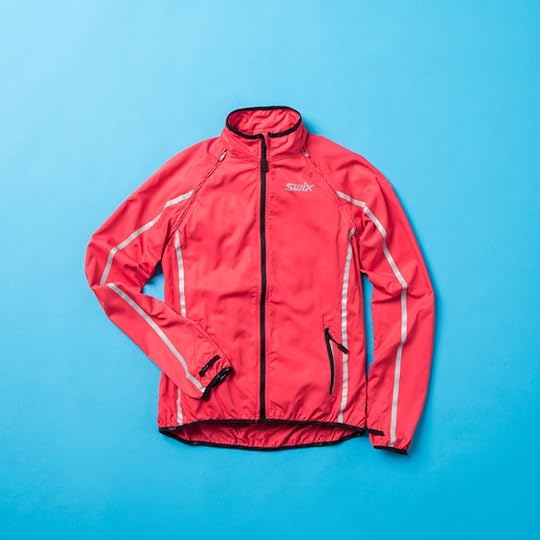
Swix Cyclon, $110
Swix, traditionally known for winter sports apparel, is expanding into the running world with its new Endurance Line. The line includes a DWR-coated, wind- and water-resistant hooded jacket that converts to a vest for flexibility on the run.

More Galleries
The post Shell Game: The Latest Weatherproof Running Jackets appeared first on Competitor.com.
4 No-Hassle Post-Workout Breakfast Recipes

Photo: Courtesy of Rocket Fuel by Matt Kadey
As the old saying goes, “breakfast is the most important meal of the day.” It’s true that a balanced morning meal brings about a slew of benefits, including better concentration and more energy. Yet those who are committed to running know that the path to better fitness is smoother when they take their post-workout nutrition just as seriously as breakfast.
With a little planning ahead, you can really improve your recovery immediately after your workout with these pre-made snacks that taste great.
Note: All recipes include substitute dairy-free, gluten-free and vegan ingredient options.
Republished with permission from “Rocket Fuel” by Matt Kadey, RD. Learn more at velopress.com/rocketfuel.
The post 4 No-Hassle Post-Workout Breakfast Recipes appeared first on Competitor.com.
Ryan Hall's Blog
- Ryan Hall's profile
- 21 followers



